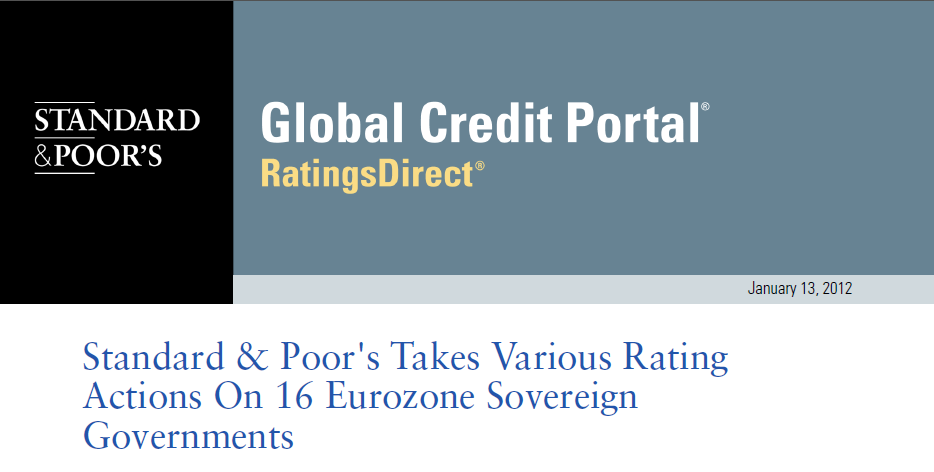On 5 December 2011, S&P put ratings of EA17 governments on rating watch negative. See my post S&P And EA17 National Governments for link to the S&P report. Today it concluded its review and downgraded several governments.
click to view the tweet on Twitter
According to the report, which can be obtained from S&P’s Tweet:
We have lowered the long-term ratings on Cyprus, Italy, Portugal, and Spain by two notches; lowered the long-term ratings on Austria, France, Malta, Slovakia, and Slovenia, by one notch; and affirmed the long-term ratings on Belgium, Estonia, Finland, Germany, Ireland, Luxembourg, and the Netherlands. All ratings have been removed from CreditWatch, where they were placed with negative implications on Dec. 5, 2011 (except for Cyprus, which was first placed on CreditWatch on Aug. 12, 2011).
The outlooks on the long-term ratings on Austria, Belgium, Cyprus, Estonia, Finland, France, Ireland, Italy, Luxembourg, Malta, the Netherlands, Portugal, Slovenia, and Spain are negative, indicating that we believe that there is at least a one-in-three chance that the rating will be lowered in 2012 or 2013. The outlook horizon for issuers with investment-grade ratings is up to two years, and for issuers with speculative-grade ratings up to one year. The outlooks on the long-term ratings on Germany and Slovakia are stable.
We assigned recovery ratings of `4′ to both Cyprus and Portugal, in accordance with our practice to assign recovery ratings to issuers rated in the speculative-grade category, indicating an expected recovery of 30%-50% should a default occur in the future.
S&P also cites that “an open and prolonged dispute among European policymakers over the proper approach to address challenges” as one of the reasons to take the rating actions.
How can the Euro Area solve its problems?
One of my favourite papers is A Simple Model Of Three Economies With Two Currencies (link) written by Wynne Godley and Marc Lavoie. The paper was written about 7-8 years back and was published in 2006 in the Cambridge Journal of Economics.
The paper’s abstract:
This paper presents a Keynesian model which describes three countries trading merchandise and financial assets with one another. It is initially assumed that all three countries have independent fiscal policies but that two of the countries share a currency, hence the model can be used to make a preliminary analysis of the conduct of economic policy in ‘the eurozone’ vis-a`-vis the rest of the world—‘the USA’. The main conclusion will be that, if all three countries do indeed operate independent fiscal policies, the system will work under a floating currency regime, but only so long as the European central bank is prepared to modify the structure of its assets by accumulating an ever rising proportion of bills issued by any ‘weak’ euro country.
G&L make an interesting remark about a possible ECB behaviour:
… If the ECB is forbidden from accommodating market-driven changes in the composition of its assets, or if the ECB rules that it will not accumulate additional stocks of securities issued by governments that have excessively large debts according to rating agencies, then fiscal policy in the ‘weak’ countries must be endogenous for stability to prevail, for otherwise it would seem that the only alternative is to let interest rates on euro bills to diverge from country to country in an unsustainable way.
Now this would seem to be a rather dismal state of affairs, from a progressive standpoint. However, it should be noted that balanced fiscal and external positions for all could as well be reached if the euro country benefiting from a (quasi) twin surplus as a result of the negative external shock on the other euro country decided to increase its government expenditures, in an effort to get rid of its budget surplus …
i.e., Euro Area nations with a weak external sector will have to deflate fiscal policy to attempt to keep the external deficit, net indebtedness to the rest of the world and interest rate in check, if surplus nations in the Euro Area do not wish to engage in fiscal expansion. Else, as G&L conclude:
Alternatively, the present structure of the European Union would need to be modified, giving far more spending and taxing power to the European Union Parliament, transforming it into a bona fide federal government that would be able to engage into substantial equalisation payments which would automatically transfer fiscal resources from the more successful to the less successful members of the euro zone. In this manner, the eurozone would be provided with a mechanism that would reduce the present bias towards downward fiscal adjustments of the deficit countries.
In my opinion, this is the only way the Euro Area can come out of the mess because it is the only way the net indebtedness of an EA nation (or a group of nations) can be prevented from exploding relative to its domestic output .
For an earlier take on the Maastricht Treaty by Wynne Godley see the article Maastricht And All That published in the London Review of Books in 1992.

